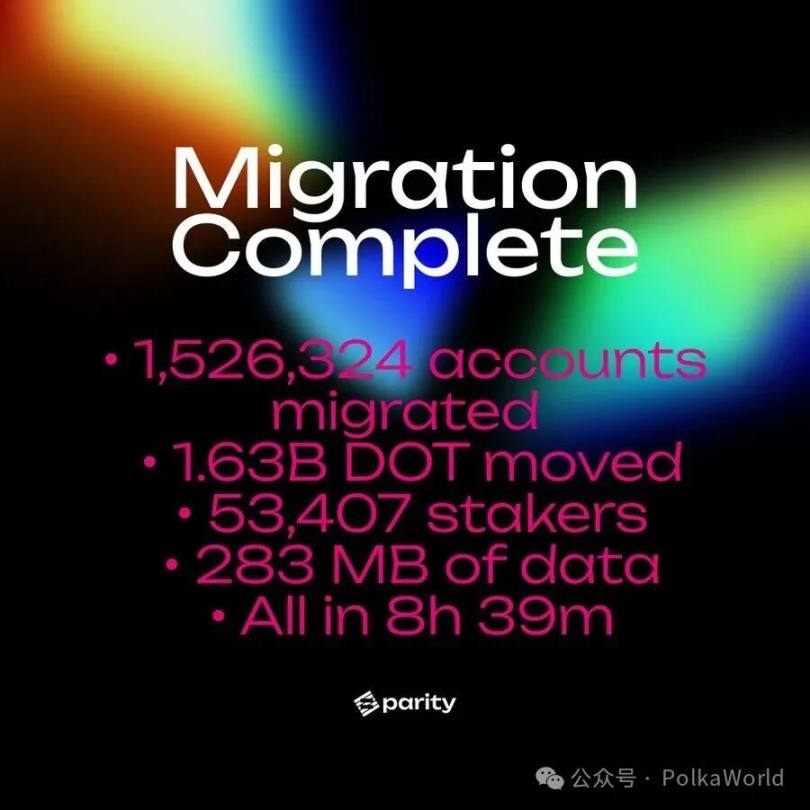Witnessing history! Polkadot successfully completes migration from Relay Chain to Asset Hub!

On November 4th, Polkadot successfully completed an unprecedented on-chain migration!
This migration was massive in scale, smooth in process, and executed perfectly—a true technical feat akin to “changing the engine mid-flight.”
Let’s look at some numbers:
- 1,526,324 accounts successfully migrated
- 1.63 billions DOT moved on-chain
- 53,407 stakers transitioned smoothly
- 283 MB of on-chain data fully migrated
- The entire process took only 8 hours and 39 minutes
- Zero forks, zero downtime, 100% on-chain execution
Behind these numbers are months of meticulous preparation and engineering miracles by the Polkadot team and ecosystem developers.

What is Asset Hub?
Asset Hub is the “asset center” of the Polkadot ecosystem—it supports the creation, management, and cross-chain transfer of all fungible and non-fungible assets within the ecosystem.
Simply put, Asset Hub is the “token factory” and “asset settlement layer” of the entire Polkadot multichain system. Any parachain or application can register assets here, make transfers, or interoperate with other chains.
Previously, Asset Hub operated under the old parachain architecture. This migration is a comprehensive upgrade—Polkadot has moved Asset Hub to the new Agile Coretime model and improved system architecture, laying the foundation for future smart contracts and cross-chain economies.
A True “On-Chain Migration Experiment”
Traditionally, a major blockchain architecture update often means a “fork” or “restart.” History has shown us many dramatic events: network outages, community splits, asset losses, or even “dual chains” coexisting.
But this time, Polkadot chose a more difficult yet more elegant path.
The migration was completed entirely on-chain, with no “downtime” or manual intervention. In other words, the network continued producing blocks and users continued operating as usual, while the migration was synchronized in the background.
The Paritytech team wrote in a tweet:
“The Asset Hub Migration is done.
No forks. No downtime. Pure on-chain execution.
Polkadot just re-engineered itself mid-flight.”
This phrase, “re-engineered itself mid-flight,” became the most vivid footnote of this event.

Why is this migration so important?
1. Paving the Way for Polkadot Hub
After the migration, Asset Hub is no longer an isolated “asset layer,” but will become a super hub integrating assets, governance, staking, and smart contract capabilities—the core component of Polkadot Hub.
In the future, REVM (Ethereum Virtual Machine compatibility layer) and PolkaVM (native RISC-V contract environment) will be deeply integrated with Asset Hub, enabling unified operation of assets, contracts, and governance.
2. Validating the Feasibility of On-Chain Autonomous Upgrades
A core philosophy of Polkadot is to enable governance and technology to be completed autonomously on-chain. The smooth completion of this migration is the best validation of on-chain governance (OpenGov) and on-chain execution.
No “hard fork team,” no “downtime window,” and no “manual coordination.” Everything was completed coherently on-chain.
3. Demonstrating the True Resilience of Polkadot’s Architecture
Polkadot’s multichain architecture is not just about “parallel processing,” but also “modular replacement.” When a part of the system needs upgrading or migration, there’s no need to interrupt the entire network. This “living evolution” capability is a key step in blockchain infrastructure evolving from a “product” to an “ecosystem.”
Technical Perspective: How Complex Was This?
The technical challenge of the migration was to seamlessly transfer the state data of over a million accounts, more than a billion DOT, the staking status of tens of thousands of stakers, and all on-chain logic to the new architecture—all without downtime.

This required:
- Precise on-chain state mapping: every account, every locked position, every voting weight had to be reproduced exactly;
- Cross-version runtime compatibility: the old chain logic and the new execution environment had to coexist during a brief transition period;
- Zero deviation at the consensus layer: any block offset, nonce disorder, or validator signature error could cause global exceptions.
In other words, this was a high-altitude “heart transplant” with virtually zero margin for error.
Completing and verifying all states within 8 hours and 39 minutes means Polkadot’s underlying mechanisms, synchronization logic, and governance toolchain have reached a very high level of maturity.
A Victory of Decentralized Team Collaboration
It’s worth noting that this migration was not completed by a single “centralized team.” It involved cross-time-zone collaboration among multiple teams:
- Parity Technologies provided the core migration scripts and verification logic;
- Web3 Foundation coordinated on-chain parameters and governance authorization;
- The Infrastructure Builders Program (IBP) operated global RPC and node redundancy assurance;
- Validators, node operators, and community developers worldwide participated in real-time monitoring and data verification.
In other words, this was a global DevOps experiment driven by a decentralized autonomous system.
Next: The Polkadot Hub Era Begins
After the Asset Hub migration, Polkadot is accelerating toward its next phase goals:
- REVM (Ethereum-compatible virtual machine) is about to go live, allowing Ethereum developers to deploy smart contracts directly on Polkadot;
- PolkaVM (native RISC-V contract environment) is preparing to launch, which will fully unleash the potential of the JAM architecture;
- The Agile Coretime market mechanism and elastic scaling are fully operational, providing flexible resource scheduling for the ecosystem;
- The combination of Cross-chain Messaging (XCM) and Hyperbridge will make cross-chain communication a “native capability.”
All of this points to a grander vision: Polkadot is no longer just a “multichain network,” but a truly high-performance, multi-core internet operating system capable of self-evolution and self-governance.
A Revolution Without Drama
In the crypto world, we’re used to “explosive events”: airdrops, surges, forks, wild volatility. But the success of this migration is, in fact, a “quiet revolution.”
It didn’t come with market hype, but it carries milestone significance. Because it proves—a truly mature blockchain doesn’t need to start over; it can evolve in place.
When an ecosystem can upgrade itself without interruption, it means it has moved from an “experimental project” to “reliable infrastructure.”
Polkadot took 8 hours and 39 minutes to complete a transition of an era. In the future, it will continue to build its own “real internet” on-chain with greater resilience and stronger interoperability.
Polkadot is “re-engineering itself mid-flight”—and will keep doing so!